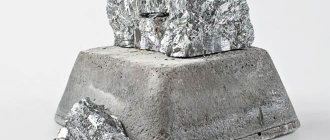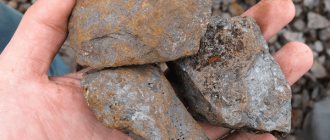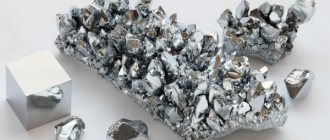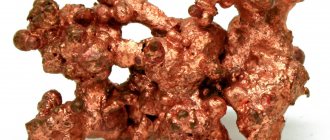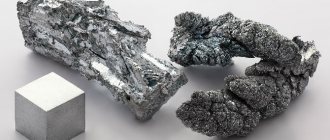- ductile, malleable and fusible shiny metal of silver-white color. It is used mainly as a safe, non-toxic, corrosion-resistant coating in its pure form or in alloys with other metals. The main industrial uses of tin are in tinplate (tinned iron) for making containers, in solders for electronics, in household piping, in bearing alloys and in coatings of tin and its alloys. The element consists of 10 isotopes with mass numbers 112, 114-120 , 122, 124; the latter is weakly radioactive; The 120Sn isotope is the most common (about 33%).
- Structure
- Properties
- Reserves and production
- Origin
- Application
- Classification
- Physical properties
- Optical properties
- Crystallographic properties
See also:
Silver
— structure and physical properties
Forms of being in nature
Tin is a chemical element rarely found in nature. Among other minerals, according to this indicator it ranks only 47th, and its content in the earth’s crust does not exceed one hundredth of a percent.
In the depths, tin has two forms of presence: dispersed and mineral. Representatives of the latter are of industrial interest. The main one among the mined minerals is cassiterite, containing 78.8% tin, a secondary role is played by stannin with 27.5% of the mineral.
Natural formations containing this chemical element include:
- rocks: basalts, diorites, dunites,
- granitoids,
- clay,
- sea water,
- the soil,
- biomass,
- ash formed by burning plants,
- stony meteorites.
origin of name
The Latin name stannum, related to the Sanskrit word meaning "steady, durable", originally referred to an alloy of lead and silver, and later to another alloy imitating it, containing about 67% tin; by the 4th century, this word began to be used to refer to tin itself.
The word tin is common Slavic, having correspondences in the Baltic languages (cf. Lit. alavas, alvas - “tin”, Prussian alwis - “lead”). It is a suffix from the root ol- (cf. Old High German elo - “yellow”, Latin albus - “white”, etc.), so the metal is named by color.
Solid phase. Minerals
There are no facts of occurrence of a dispersed form of this phase in sediments. While in mineral concentrations, along with a number of other minerals, such as biotites, garnets, magnesites, pyroxenes, tourmalines and Fe+2 iron, tin is present in mineral form. It is also found in isomorphic form among sulfide deposits of sphalerites, pyrites and chalcopyrites.
Native elements, alloys and intermetallic compounds
Nuggets of non-ferrous and precious metals found among a number of geological formations often contain tin. It is also found in alloys with antimony and lead, with copper and antimony. In the form of intermetallic compounds, it can be found among atakites, zvyagintsevites, stistaites, taymyrites and shtumyrlites.
Tin
All these formations are present in the following rock groups:
- intrusive and effusive igneous,
- hydrothermally and metasomatically altered,
- modern education,
- sedimentary
Tin oxide compounds
Tin compounds with oxygen are presented in chemistry:
- Tin oxide SnO2 – cassiterite.
- Tin oxide SnO - brown oxide.
- Tetravalent tin oxide SnO2 – tin anhydride.
Cassiterite
The main industrial mineral for the extraction of tin, containing almost four-fifths of the required substance. It is an amorphous white powder with a density of 7036 kg/m3 or colorless crystals with a density of 6950 kg/m3. Both fractions in deposits can be identified in the form of grains, separate clusters, or continuous massifs.
Cassiterite is chemically stable, does not interact well with liquids, has a matte sheen and a conchoidal fracture.
Hydroxide compounds
Formed by the reaction of polytin acids or by other joining methods:
- Varlamovit,
- hydromartite,
- copper hydrostannate,
- mushistonite,
- solidified magnetite solution of tin.
These minerals do not play a significant role in the industrial production of the metal.
Silicates
Rock-forming compounds of the earth's crust are represented in nature by the following tin-containing substances:
- Malayatite, which forms clusters of interest to mineral developers.
- Pabstite is a rare mineral of the benitonite group, found in silicified limestone.
- Stokazite.
Spindles
A significant group of ocahedral crystals. In their environment there is nigerite, a mineral containing tin and named after the country where it is located - Nigeria.
Tin sulfide compounds
When combined with sulfur, tin forms a number of industrially quite important compounds:
- Herzenbergite is a mineral with a brown color.
- Berndtite is a bright yellow substance.
- Kesterite.
- Tillit.
- Frankeite.
Stannin
In terms of its practical significance, it is the second among tin-containing minerals, often found in Russia. Tin pyrite is a class of sulfides, usually combined with varlamovite, representing a third of the available tin in deposits. A crystalline substance with a metallic luster, often subject to decay.
Story
Tin was known to man already in the 4th millennium BC. e. This metal was inaccessible and expensive, so products made from it are rarely found among Roman and Greek antiquities. There are mentions of tin in the Bible, the Fourth Book of Moses. Tin is (along with copper) one of the components of tin bronze, invented at the end or middle of the 3rd millennium BC. e.. Since bronze was the most durable metal and alloy known at that time, tin was a “strategic metal” throughout the “Bronze Age”, more than 2000 years (very approximately: 35-11 centuries BC).
Drop of molten tin
Forms in liquid phase
Conducted scientific research and experiments indicate in favor of the content of tin in mineral solutions with some degree of probability. It remains to be stated that this issue requires further study.
Nevertheless, the forms of presence of the mineral in solutions established during the experiments can be grouped as follows:
- Ionic compounds, a group of which includes: halides, hydroxyl compounds, simple tin ions and sulfides.
- Complex compounds formed when cassiterite is dissolved in fluorinated media.
- Tin-silicon and colloidal compounds.
Physiological action
Almost nothing is known about the role of tin in living organisms. The human body contains approximately (1-2) 10-4% tin, and its daily intake from food is 0.2-3.5 mg. Tin metal is non-toxic, which allows it to be used in the food industry. Tin poses a danger to humans in the form of vapors and various aerosol particles and dust. When exposed to tin vapors or dust, stannosis can develop - lung damage. Stannan (tin hydrogen) is a powerful poison. Some organotin compounds are also very toxic. The temporary permissible concentration of tin compounds in atmospheric air is 0.05 mg/m3, the maximum permissible concentration of tin in food products is 200 mg/kg, in dairy products and juices - 100 mg/kg. The toxic dose of tin for humans is 2 g.
Harmful impurities contained in tin under normal conditions of storage and use, including in the melt at temperatures up to 600 °C, are not released into the air of the working area in volumes exceeding the maximum permissible concentration in accordance with GOST. Long-term (15-20 years) exposure to tin dust has a fibrogenic effect on the lungs and can cause pneumoconiosis in workers.
Extraction methods
Ore mining methods are always determined by the shape and conditions of occurrence. Placer (alluvial) deposits saturated with granular sands are the easiest to develop.
Dredging
The method consists in extracting a placer containing tin from the bottom of lakes, rivers, artificial reservoirs or even seas using suction or multi-bucket dredges.
Tin mining
A dredge is a moving dredging machine mounted on a wooden or steel pontoon, which takes up underwater soil from the front and unloads the processed rock into a dump at the rear. Thus, this mining and processing unit moving along the water surface solves several problems at once:
- Extracts minerals.
- Carries out the gravitational beneficiation process, which includes screening, mineral depositing and concentration.
- Deepens the bed of the reservoir.
As a result of dredging, a cassiterite concentrate is obtained.
Using sand pumps
Here the initial opening of the top layer of waste rock is carried out using special equipment. After that, the ore body is eroded by high-pressure water jets, as a result of which the resulting waste flows into the underlying storage pond.
The water-mud suspension is fed upward to the washing gallery using sand units. Next, the liquid fraction flows down through the wash gates, and the heavier cassiterite remains at the bottom, from where it is then taken for jigging and concentration. As a result of the process, raw materials are obtained with a tin content of 70-76%.
Refining
Tin production includes not only the extraction and enrichment of ores, but also smelting followed by refining.
Smelting is carried out in reverberatory or special shaft furnaces using carbon-containing materials. Using this technological process, rough tin is obtained. Immediately before smelting, the ore is subjected to roasting or technological weathering to remove unnecessary rocks.
Refining is the purification of a material from impurities for the purpose of its further use in a more concentrated form.
Thermal
It is performed in hemispherical steel boilers at a temperature of +3000C. Using thermal refining, we achieve the removal of:
- Iron and copper with sulfur and coal.
- Arsenic and antimony by alloying them with aluminum.
- Lead under the influence of tin chloride.
- Bismuth, due to connecting reactions with magnesium and calcium.
As a result, the concentration of tin in the refined metal reaches 99.75-99.95%.
Electrolytic
Using this method, first tested on heavily contaminated Bolivian ores, 99.98% purification of the source material is achieved. It is based on the process of electrolysis in baths at 300C, where an electrolyte containing an acidic set and divalent tin is added.
For use in the manufacture of semiconductor products, the raw materials obtained after electrolytic refining are additionally subjected to zone melting, which makes it possible to achieve 99.995% metal purity.
Tin Plague
Gray and white tin
At temperatures below 13.2 °C, the specific volume of pure tin increases by 25.6%, and it spontaneously transforms into another phase state - gray tin (α-Sn), in the crystal lattice of which the atoms are arranged less densely. One modification changes to another the faster the lower the ambient temperature. At −33 °C the transformation rate becomes maximum. The tin cracks and turns to powder. Moreover, the contact of gray tin and white leads to “infection” of the latter. The combination of these phenomena is called the “tin plague.” The current name for this process was given by G. Cohen in 1911. The scientific study of this phase transition began in 1870 with the work of the St. Petersburg scientist, academician J. Fritzsche. It has been established that this is a process of allotropic transformation of white tin into gray tin with a diamond-type structure. Many valuable observations and thoughts about this process were expressed by D. I. Mendeleev in his “Fundamentals of Chemistry”.
White tin is a silvery-white, shiny metal with a specific tetragonal structure and an s2p2 electronic state - the β phase. Gray tin is a covalent crystal with a diamond structure and an sp3 electronic state - the α phase. Phase transitions of tin from white to gray and back are accompanied by a restructuring of the electronic structure and a strong (25.6%) volume effect. White tin can be supercooled to helium temperatures (phase α-β equilibrium temperature of about +13.2 °C).
One way to prevent the “tin plague” is to add a stabilizer, such as bismuth, to the tin. On the other hand, the catalyst accelerating the transition of white tin to gray at not very low temperatures is ammonium chlorostannate (NH4)2SnCl6.
Interesting facts:
- The “tin plague” is one of the reasons for the death of Scott’s expedition to the South Pole in 1912. It was left without fuel due to the fact that fuel leaked from tin-sealed tanks affected by the “tin plague.”
- Some historians point to the “tin plague” as one of the circumstances of the defeat of Napoleon’s army in Russia in 1812 - severe frosts led to the transformation of tin buttons on soldiers’ uniforms into powder.
- The “Tin Plague” destroyed many valuable collections of tin soldiers. For example, in the storerooms of the St. Petersburg Museum of Alexander Suvorov, dozens of figurines turned into dust - in the basement where they were stored, the heating radiators burst in winter.
Scope of application
Due to its properties: low melting point, a wide range of easily produced alloys, resistance to acid attacks, tin has found wide use in a number of industries.
The metal itself is largely used as a non-toxic anti-corrosion coating, valued in the manufacture of food containers. It is also found in solders, chemicals, tin powder and gray cast iron. Most often it can be found in the form of beautiful decorative coatings, although also on the surface of pipes in use. In addition, tin serves as an anode material in chemical power sources and is an alloying material in the production of titanium structural alloys.
However, tin alloys have become much more widespread. Bronze, various solders, printing inks, dye coating of textiles and wool, superconductors, heat-resistant materials, gamma emitters - all this was born thanks to a wide range of alloys of this silver-white metal.
PROPERTIES
The density of b-Sn is 7.29 g/cm3, the density of a-Sn is 5.85 g/cm3. Melting point 231.9°C, boiling point 2270°C. Temperature coefficient of linear expansion 23·10-6 (0-100 °C); specific heat capacity (0°C) 0.225 kJ/(kg K), that is, 0.0536 cal/(g °C); thermal conductivity (0°C) 65.8 W/(m K), that is, 0.157 cal/(cm sec °C); specific electrical resistance (20 °C) 0.115·10-6 ohm·m, that is, 11.5·10-6 ohm·cm. Gray tin is diamagnetic, and white tin is paramagnetic.
Tensile strength 16.6 MN/m2 (1.7 kgf/mm2); relative elongation 80-90%; Brinell hardness 38.3-41.2 Mn/m2 (3.9-4.2 kgf/mm2). When bending tin rods, a characteristic crunch is heard from the mutual friction of the crystallites.
Pure tin has low mechanical strength at room temperature (you can bend a tin rod and hear a characteristic cracking sound caused by the friction of individual crystals against each other) and is therefore rarely used.
Deposits in Russia and the world
The largest deposits of tin ores in the world are located:
- in Asia - China, Indonesia, Thailand, Malaysia, Myanmar;
- in South America - Bolivia, Brazil, Peru;
- continent and country of Australia.
On the territory of our country there are 271 tin ore deposits: 147 alluvial and 124 primary. They are located in Karelia, the Irkutsk and Magadan regions, the Transbaikal, Khabarovsk and Primorsky territories, the Jewish Autonomous Okrug of Buryatia, Yakutia and Chukotka.
Tin mining countries
The world leaders in tin mining in 2021 are:
- China – 85.0 thousand tons.
- Indonesia – 80.0 thousand tons.
- Myanmar - 54.0 thousand tons.
- Peru – 18.5 thousand tons.
- Bolivia - 17.0 thousand tons.
- Brazil – 17.0 thousand tons.
- Congo - 10.0 thousand tons.
- Nigeria – 7.5 thousand tons.
- Australia – 7.0 thousand tons.
- Vietnam – 4.5 thousand tons.
- Malaysia – 4.0 thousand tons.
- Rwanda – 3.0 thousand tons.
- Russia – 1.4 thousand tons.
- Laos – 1.0 thousand tons.
Author: Yuri Florinskikh All articles by this author
Latest articles by the author: The largest producers of milk and dairy products in the world Diamonds: properties, mining methods and applications
